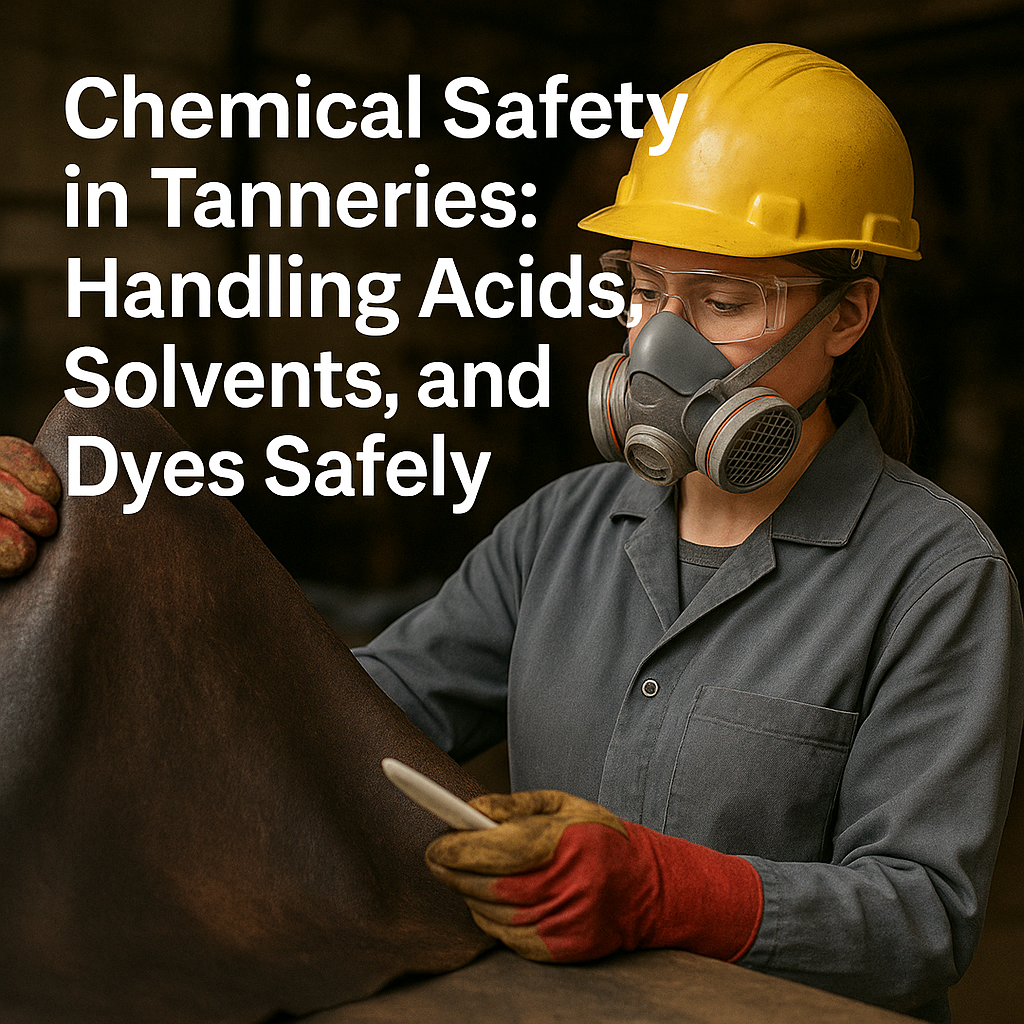Chemical Safety in Tanneries is critical for ensuring worker health, operational efficiency, and environmental protection. With daily exposure to hazardous substances like acids, solvents, and dyes, leather production workers face serious risks.

Following strong chemical safety protocols not only prevents workplace accidents but also ensures compliance with health regulations such as those outlined by OSHA and Safe Work Australia (DoFollow links).
Let’s dive into how you can build a safer, healthier tannery environment.
- Understanding the Chemical Hazards in Tanneries
- Best Practices for Handling Acids in Tanneries
- Best Practices for Handling Solvents Safely
- Best Practices for Safe Dye Handling
- Personal Protective Equipment (PPE) for Chemical Safety in Tanneries
- Key Strategies to Enhance Overall Chemical Safety
- Conclusion: Prioritize Chemical Safety in Tanneries for a Healthier Future
Understanding the Chemical Hazards in Tanneries
Tanneries use a wide variety of chemicals at different stages of leather processing, including:
- Acids (Sulfuric acid, Formic acid): Used for pH adjustments in the pickling and tanning process.
- Solvents (Toluene, Acetone, Alcohols): Found in cleaning, finishing, and adhesive applications.
- Dyes (Aniline-based, Metal Complex Dyes): Used in coloring leather for consumer goods.
Each chemical group presents specific hazards such as:
- Skin burns and dermatitis
- Eye irritation and vision loss
- Respiratory issues due to inhalation of fumes
- Chemical explosions and fires
- Environmental contamination through spills or improper disposal
Without proper controls, these hazards can lead to chronic health conditions, workplace incidents, or regulatory fines.

Best Practices for Handling Acids in Tanneries
Safe handling of acids is essential to minimize severe burns and inhalation injuries.
- Use Acid-Resistant PPE: Workers must wear acid-resistant gloves, aprons, face shields, and boots.
- Proper Storage: Store acids in designated, ventilated areas with secondary containment systems.
- Dilution Protocols: Always add acid to water, never water to acid, to prevent violent reactions.
- Emergency Readiness: Install accessible eye wash stations and emergency showers near acid handling zones.
- Training and Signage: Workers must be trained on safe acid handling procedures and emergency response.
Resources like CCOHS (DoFollow link) emphasize the importance of labeling and Material Safety Data Sheets (MSDS) for all acid containers.
Best Practices for Handling Solvents Safely
Solvents are highly flammable and toxic if inhaled, making chemical safety in tanneries even more complex.
- Use in Well-Ventilated Areas: Install mechanical ventilation or fume hoods where solvent work occurs.
- Static Control Measures: Use grounding and bonding to prevent static-induced fires during solvent transfers.
- Spill Containment Kits: Keep appropriate spill kits nearby to address accidental leaks promptly.
- Fire Extinguishers: Position Class B fire extinguishers (suitable for flammable liquids) within easy reach.
- Limit Exposure Time: Rotate tasks when possible to reduce prolonged exposure to solvent vapors.
For more about industrial solvent safety, consult the National Fire Protection Association (NFPA) (DoFollow link) guidelines.
Best Practices for Safe Dye Handling
Dyes used in tanneries often contain heavy metals or volatile organic compounds (VOCs) that require special attention.
- Wear Respiratory Protection: Especially when handling powdered dyes or spraying dye solutions.
- Protective Clothing: Use full-body coverings to avoid skin staining or absorption.
- Minimize Aerosols: Apply dyes using controlled methods like brushing rather than spraying when possible.
- Environmental Controls: Implement proper dye waste disposal systems to avoid contamination of water sources.
- Labeling and Storage: Clearly label dye containers and store them separately from incompatible substances.
The environmental consequences of dye spills can be massive. Organizations like OHSE.ca (DoFollow link) offer helpful resources for eco-friendly tannery practices.
Personal Protective Equipment (PPE) for Chemical Safety in Tanneries

| PPE Item | Purpose |
|---|---|
| Chemical-Resistant Gloves | Prevents burns and skin absorption |
| Face Shields and Goggles | Shields eyes from splashes |
| Respiratory Protection | Filters out solvent and dye fumes |
| Protective Clothing | Guards against splashes, aerosols, and burns |
| Non-Slip, Chemical-Resistant Boots | Protects feet from spills and splashes |
Encouraging strict PPE compliance is a key component of achieving full chemical safety in tanneries.
Key Strategies to Enhance Overall Chemical Safety
Chemical Safety in Tanneries isn’t just about wearing PPE or posting signs — it’s about building a safety-first culture.
Here’s how to strengthen your program:
- Conduct Regular Risk Assessments: Identify new hazards as processes change.
- Develop a Chemical Hygiene Plan (CHP): Formalize procedures for handling, storage, and disposal.
- Emergency Drills: Regularly practice chemical spill responses and evacuation protocols.
- Continuous Worker Training: Update training whenever new chemicals or equipment are introduced.
- Supplier Verification: Only purchase chemicals from reputable vendors who provide complete safety data.
You can also enhance your safety documentation and learning using online training platforms like LinkedIn Learning (DoFollow link), which offer compliance and industrial safety courses.
Conclusion: Prioritize Chemical Safety in Tanneries for a Healthier Future
Chemical Safety in Tanneries must be the cornerstone of every leather production operation. With diligent PPE use, proper chemical handling, ongoing training, and strong emergency response systems, tanneries can protect their most valuable resource — their workers.

Remember: Safety isn’t a regulation to tick off; it’s a commitment to everyone’s well-being, productivity, and environmental stewardship.
In the world of leather production, protecting your team from acids, solvents, and dyes today ensures your business continues crafting quality products tomorrow — safely and sustainably.

No comments yet